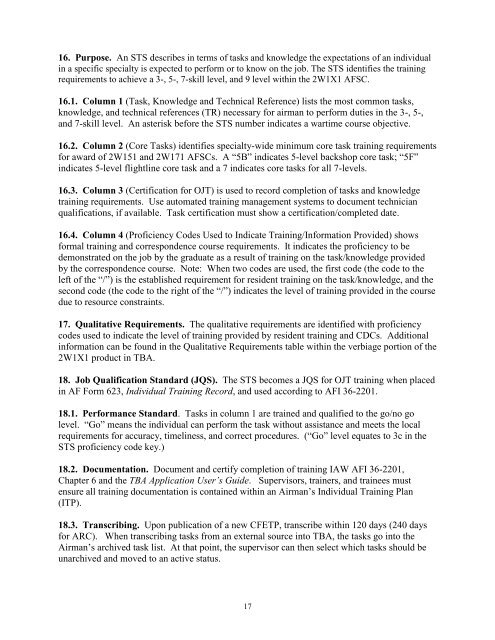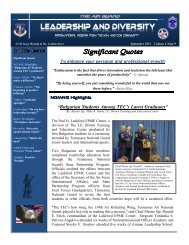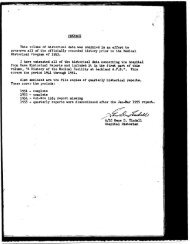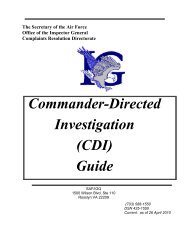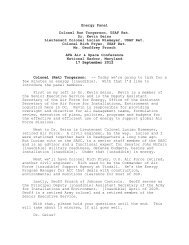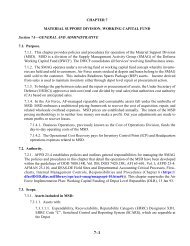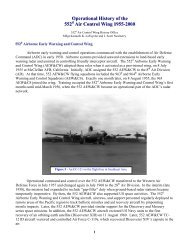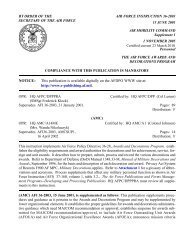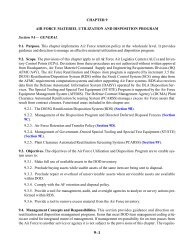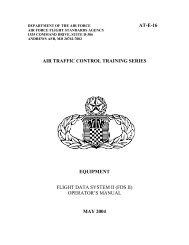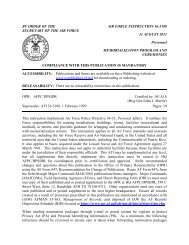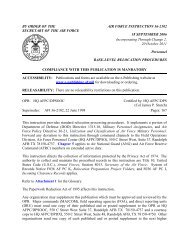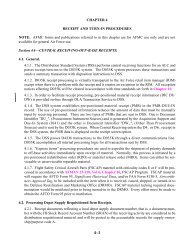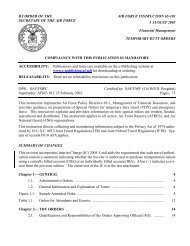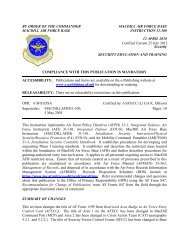AFSC 2W1X1 AIRCRAFT ARMAMENT SYSTEMS ... - Air Force Link
AFSC 2W1X1 AIRCRAFT ARMAMENT SYSTEMS ... - Air Force Link
AFSC 2W1X1 AIRCRAFT ARMAMENT SYSTEMS ... - Air Force Link
You also want an ePaper? Increase the reach of your titles
YUMPU automatically turns print PDFs into web optimized ePapers that Google loves.
16. Purpose. An STS describes in terms of tasks and knowledge the expectations of an individual<br />
in a specific specialty is expected to perform or to know on the job. The STS identifies the training<br />
requirements to achieve a 3-, 5-, 7-skill level, and 9 level within the <strong>2W1X1</strong> <strong>AFSC</strong>.<br />
16.1. Column 1 (Task, Knowledge and Technical Reference) lists the most common tasks,<br />
knowledge, and technical references (TR) necessary for airman to perform duties in the 3-, 5-,<br />
and 7-skill level. An asterisk before the STS number indicates a wartime course objective.<br />
16.2. Column 2 (Core Tasks) identifies specialty-wide minimum core task training requirements<br />
for award of 2W151 and 2W171 <strong>AFSC</strong>s. A ―5B‖ indicates 5-level backshop core task; ―5F‖<br />
indicates 5-level flightline core task and a 7 indicates core tasks for all 7-levels.<br />
16.3. Column 3 (Certification for OJT) is used to record completion of tasks and knowledge<br />
training requirements. Use automated training management systems to document technician<br />
qualifications, if available. Task certification must show a certification/completed date.<br />
16.4. Column 4 (Proficiency Codes Used to Indicate Training/Information Provided) shows<br />
formal training and correspondence course requirements. It indicates the proficiency to be<br />
demonstrated on the job by the graduate as a result of training on the task/knowledge provided<br />
by the correspondence course. Note: When two codes are used, the first code (the code to the<br />
left of the ―/‖) is the established requirement for resident training on the task/knowledge, and the<br />
second code (the code to the right of the ―/‖) indicates the level of training provided in the course<br />
due to resource constraints.<br />
17. Qualitative Requirements. The qualitative requirements are identified with proficiency<br />
codes used to indicate the level of training provided by resident training and CDCs. Additional<br />
information can be found in the Qualitative Requirements table within the verbiage portion of the<br />
<strong>2W1X1</strong> product in TBA.<br />
18. Job Qualification Standard (JQS). The STS becomes a JQS for OJT training when placed<br />
in AF Form 623, Individual Training Record, and used according to AFI 36-2201.<br />
18.1. Performance Standard. Tasks in column 1 are trained and qualified to the go/no go<br />
level. ―Go‖ means the individual can perform the task without assistance and meets the local<br />
requirements for accuracy, timeliness, and correct procedures. (―Go‖ level equates to 3c in the<br />
STS proficiency code key.)<br />
18.2. Documentation. Document and certify completion of training IAW AFI 36-2201,<br />
Chapter 6 and the TBA Application User’s Guide. Supervisors, trainers, and trainees must<br />
ensure all training documentation is contained within an <strong>Air</strong>man’s Individual Training Plan<br />
(ITP).<br />
18.3. Transcribing. Upon publication of a new CFETP, transcribe within 120 days (240 days<br />
for ARC). When transcribing tasks from an external source into TBA, the tasks go into the<br />
<strong>Air</strong>man’s archived task list. At that point, the supervisor can then select which tasks should be<br />
unarchived and moved to an active status.<br />
17


